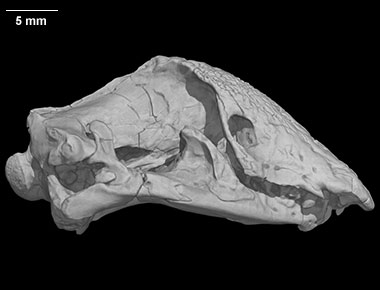This page serves supplemental imagery for a paper entitled Skull Osteology of the Eocene amphisbaenian Spathorhynchus fossorium (Reptilia, Squamata) Suggests Convergent Evolution and Reversals of Fossorial Adaptations in Worm Lizards by J. Müller, C.A. Hipsley and J.A. Maisano (In press, Journal of Anatomy). The abstract is as follows:
The fossorial amphisbaenians, or worm lizards, are characterized by a suite of specialized characters in the skull and postcranium, however fossil evidence suggests that at least some of these shared derived traits evolved convergently. Unfortunately the lack of detailed knowledge of many fossil taxa has rendered a more precise interpretation difficult. Here we describe the cranial anatomy of the oldest-known well-preserved amphisbaenian, Spathorhynchus fossorium, from the Eocene Green River Formation, Wyoming, USA, using high-resolution X-ray computed tomography (HRXCT). This taxon possesses one of the most strongly reinforced crania known among amphisbaenians, with many dermal bones overlapping each other internally. In contrast to modern taxa, S. fossorium has a paired orbitosphenoid, lacks a true compound bone in the mandible, and possesses a fully enclosed orbital rim. The last feature represents a highly derived structure in that the jugal establishes contact with the frontal internally, reinforcing the posterior orbital margin. S. fossorium also possesses a strongly modified Vidian canal with a previously unknown connection to the ventral surface of the parabasisphenoid. Comparison with the closely related fossil taxon Dyticonastis rensbergeri reveals that these derived traits are also shared by the latter species and potentially represent synapopmorphies of an extinct Paleogene clade of amphisbaenians. The presence of a reinforced orbital rim suggests selection against the loss of a functional eye and indicates an ecology potentially different from modern taxa. Given the currently accepted phylogenetic position of Spathorhynchus and Dyticonastis, we predict that supposedly ‘unique’ cranial traits traditionally linked to fossoriality such as a fused orbitosphenoid and the reduction of the eye show a more complex character history than previously assumed, including both parallel evolution and reversals to superficially primitive conditions.

About the Species
This specimen, the holotype, was collected from the Middle Eocene Green River Formation of Sweetwater County, Wyoming on 27 July 1967 by Frank L. Pearce. It was made available to The University of Texas High-Resolution X-ray CT Facility for scanning by Dr. Jessie Maisano of The University of Texas at Austin and Dr. Matthew Carrano of the National Museum of Natural History. Funding for scanning and image processing was provided by a National Science Foundation Assembling the Tree of Life grant (EF-0334961), The Deep Scaly Project: Resolving Squamate Phylogeny using Genomic and Morphological Approaches, to Drs. Jacques Gauthier of Yale University, Maureen Kearney (formerly of the Field Museum), Mike Lee of the University of Adelaide, Jessie Maisano of The University of Texas at Austin, Todd Reeder of San Diego State University, Olivier Rieppel of the Field Museum, Jack Sites of Brigham Young University, and John Wiens of the University of Arizona.

About this Specimen
The specimen was scanned by Matthew Colbert on 17 February 2005 along the coronal axis for a total of 750 slices. Each 1024x1024 pixel slice is 0.047 mm thick, with an interslice spacing of 0.047 mm and a field of reconstruction of 22 mm.
Click here to download the original HRXCT scan data (1.0 Gb).

About the
Scan
Literature
Berman, D.S. 1973. Spathorhynchus fossorium, a Middle Eocene Amphisbaenian (Reptilia) from Wyoming. Copeia 1973:704-721.

Literature
& Links
Three-dimensional volumetric renderings of the isolated lower jaw with matrix rendered transparent. Movies are 4 mb or less.

Additional Imagery
 |



 ,
, 







